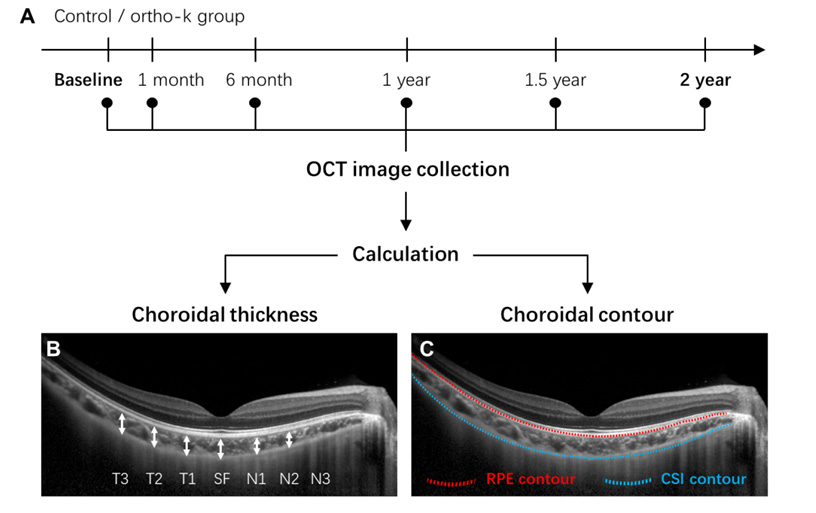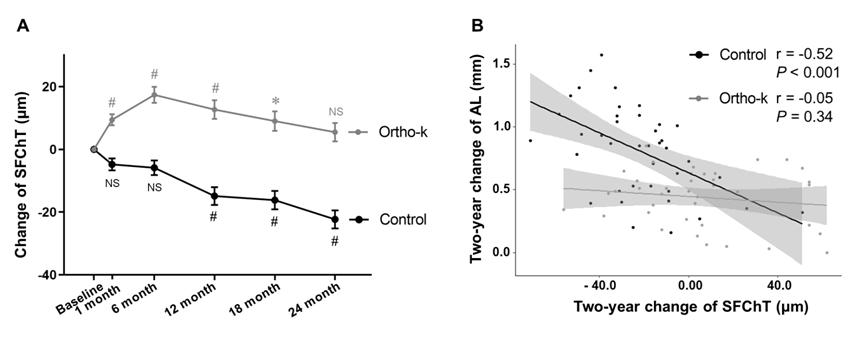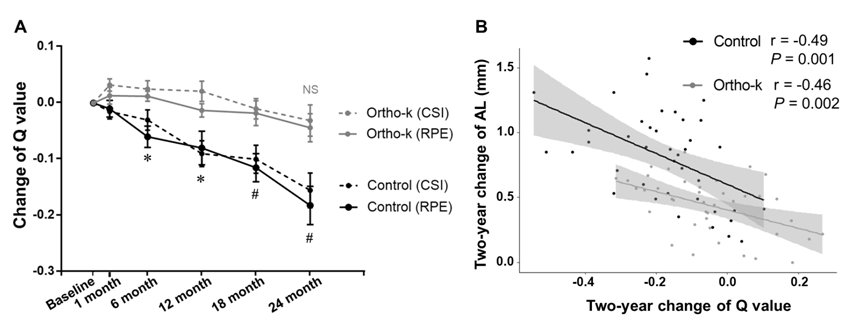1、Morgan IG, Ohno-Matsui K, Saw SM. Myopia[ J]. Lancet, 2012,
379(9827):1739-1748. DOI: 10.1016/S0140-6736(12)60272-4.
DOI:10.1016/S0140-6736(12)60272-4.Morgan IG, Ohno-Matsui K, Saw SM. Myopia[ J]. Lancet, 2012,
379(9827):1739-1748. DOI: 10.1016/S0140-6736(12)60272-4.
DOI:10.1016/S0140-6736(12)60272-4.
2、Wang J, Li Y, Musch DC, et al. Progression of myopia in school-aged
children after COVID-19 home confinement[ J]. JAMA Ophthalmol,
2021, 139(3): 293-300. DOI: 10.1001/jamaophthalmol.2020.6239.Wang J, Li Y, Musch DC, et al. Progression of myopia in school-aged
children after COVID-19 home confinement[ J]. JAMA Ophthalmol,
2021, 139(3): 293-300. DOI: 10.1001/jamaophthalmol.2020.6239.
3、Hu Y, Zhao F, Ding X, et al. Rates of myopia development in young
Chinese schoolchildren during the outbreak of COVID-19[ J].
JAMA Ophthalmol, 2021, 139(10): 1115-1121. DOI: 10.1001/
jamaophthalmol.2021.3563.Hu Y, Zhao F, Ding X, et al. Rates of myopia development in young
Chinese schoolchildren during the outbreak of COVID-19[ J].
JAMA Ophthalmol, 2021, 139(10): 1115-1121. DOI: 10.1001/
jamaophthalmol.2021.3563.
4、Holden BA, Fricke TR , Wilson DA, et al. Global prevalence of
myopia and high myopia and temporal trends from 2000 through
2050[ J]. Ophthalmology, 2016, 123(5): 1036-1042. DOI: 10.1016/
j.ophtha.2016.01.006.Holden BA, Fricke TR , Wilson DA, et al. Global prevalence of
myopia and high myopia and temporal trends from 2000 through
2050[ J]. Ophthalmology, 2016, 123(5): 1036-1042. DOI: 10.1016/
j.ophtha.2016.01.006.
5、Haarman AEG, Enthoven CA, et al. The complications of myopia: a
review and meta-analysis[ J]. Invest Ophthalmol Vis Sci, 2020, 61(4):
49. DOI: 10.1167/iovs.61.4.49.Haarman AEG, Enthoven CA, et al. The complications of myopia: a
review and meta-analysis[ J]. Invest Ophthalmol Vis Sci, 2020, 61(4):
49. DOI: 10.1167/iovs.61.4.49.
6、Huang J, Wen D, Wang Q, et al. Eff icac y comparison of 16
interventions for myopia control in children: a network meta�analysis[ J]. Ophthalmology, 2016, 123(4): 697-708. DOI: 10.1016/
j.ophtha.2015.11.010.Huang J, Wen D, Wang Q, et al. Eff icac y comparison of 16
interventions for myopia control in children: a network meta�analysis[ J]. Ophthalmology, 2016, 123(4): 697-708. DOI: 10.1016/
j.ophtha.2015.11.010.
7、Cho P, Cheung SW. Retardation of myopia in Orthokeratology
(ROMIO) study: a 2-year randomized clinical trial[ J]. Invest
Ophthalmol Vis Sci, 2012, 53(11): 7077-7085. DOI: 10.1167/iovs.12-
10565.Cho P, Cheung SW. Retardation of myopia in Orthokeratology
(ROMIO) study: a 2-year randomized clinical trial[ J]. Invest
Ophthalmol Vis Sci, 2012, 53(11): 7077-7085. DOI: 10.1167/iovs.12-
10565.
8、Hiraoka T, Kakita T, Okamoto F, et al. Long-term effect of overnight
orthokeratology on axial length elongation in childhood myopia: a
5-year follow-up study[ J]. Invest Ophthalmol Vis Sci, 2012, 53(7):
3913-3919. DOI: 10.1167/iovs.11-8453.Hiraoka T, Kakita T, Okamoto F, et al. Long-term effect of overnight
orthokeratology on axial length elongation in childhood myopia: a
5-year follow-up study[ J]. Invest Ophthalmol Vis Sci, 2012, 53(7):
3913-3919. DOI: 10.1167/iovs.11-8453.
9、Xu S, Li Z, Zhao W, et al. Effect of atropine, orthokeratology and
combined treatments for myopia control: a 2-year stratified randomised
clinical trial[ J]. Br J Ophthalmol, 2023, 107(12): 1812-1817. DOI:
10.1136/bjo-2022-321272Xu S, Li Z, Zhao W, et al. Effect of atropine, orthokeratology and
combined treatments for myopia control: a 2-year stratified randomised
clinical trial[ J]. Br J Ophthalmol, 2023, 107(12): 1812-1817. DOI:
10.1136/bjo-2022-321272
10、Cho P, Tan Q. Myopia and orthokeratology for myopia control[ J]. Clin Exp Optom, 2019, 102(4): 364-377. DOI: 10.1111/cxo.12839.Cho P, Tan Q. Myopia and orthokeratology for myopia control[ J]. Clin Exp Optom, 2019, 102(4): 364-377. DOI: 10.1111/cxo.12839.
11、Lau JK , Wan K , Cho P. Orthokeratology lenses with increased
compression factor (OKIC): a 2-year longitudinal clinical trial for
myopia control[ J]. Cont Lens Anterior Eye, 2023, 46(1): 101745.
DOI: 10.1016/j.clae.2022.101745.Lau JK , Wan K , Cho P. Orthokeratology lenses with increased
compression factor (OKIC): a 2-year longitudinal clinical trial for
myopia control[ J]. Cont Lens Anterior Eye, 2023, 46(1): 101745.
DOI: 10.1016/j.clae.2022.101745.
12、Baird PN, Saw SM, Lanca C, et al. Myopia[ J]. Nat Rev Dis Primers,
2020, 6(1):99. DOI: 10.1038/s41572-020-00231-4Baird PN, Saw SM, Lanca C, et al. Myopia[ J]. Nat Rev Dis Primers,
2020, 6(1):99. DOI: 10.1038/s41572-020-00231-4
13、Jonas JB, Ang M, Cho P, et al. IMI prevention of myopia and its
progression[ J]. Invest Ophthalmol Vis Sci, 2021, 62(5): 6. DOI:
10.1167/iovs.62.5.6.Jonas JB, Ang M, Cho P, et al. IMI prevention of myopia and its
progression[ J]. Invest Ophthalmol Vis Sci, 2021, 62(5): 6. DOI:
10.1167/iovs.62.5.6.
14、Xiong S, He X, Zhang B, et al. Changes in choroidal thickness varied
by age and refraction in children and adolescents: a 1-year longitudinal
study[ J]. Am J Ophthalmol, 2020, 213: 46-56. DOI: 10.1016/
j.ajo.2020.01.003.Xiong S, He X, Zhang B, et al. Changes in choroidal thickness varied
by age and refraction in children and adolescents: a 1-year longitudinal
study[ J]. Am J Ophthalmol, 2020, 213: 46-56. DOI: 10.1016/
j.ajo.2020.01.003.
15、Tian F, Zheng D, Zhang J, et al. Choroidal and retinal thickness and
axial eye elongation in Chinese junior students[ J]. Invest Ophthalmol
Vis Sci, 2021, 62(9): 26. DOI: 10.1167/iovs.62.9.26.Tian F, Zheng D, Zhang J, et al. Choroidal and retinal thickness and
axial eye elongation in Chinese junior students[ J]. Invest Ophthalmol
Vis Sci, 2021, 62(9): 26. DOI: 10.1167/iovs.62.9.26.
16、Zhou X, Zhang S, Zhang G, et al. Increased choroidal blood perfusion
can inhibit form deprivation myopia in guinea pigs[ J]. Invest
Ophthalmol Vis Sci, 2020, 61(13): 25. DOI: 10.1167/iovs.61.13.25.Zhou X, Zhang S, Zhang G, et al. Increased choroidal blood perfusion
can inhibit form deprivation myopia in guinea pigs[ J]. Invest
Ophthalmol Vis Sci, 2020, 61(13): 25. DOI: 10.1167/iovs.61.13.25.
17、Wu H, Chen W, Zhao F, et al. Scleral hypoxia is a target for myopia
control[ J]. Proc Natl Acad Sci USA, 2018, 115(30): E7091-E7100.
DOI: 10.1073/pnas.1721443115Wu H, Chen W, Zhao F, et al. Scleral hypoxia is a target for myopia
control[ J]. Proc Natl Acad Sci USA, 2018, 115(30): E7091-E7100.
DOI: 10.1073/pnas.1721443115
18、Chiang STH, Chen TL, Phillips JR . Effect of optical defocus on
choroidal thickness in healthy adults with presbyopia[ J]. Invest
Ophthalmol Vis Sci, 2018, 59(12): 5188-5193. DOI: 10.1167/iovs.18-
24815Chiang STH, Chen TL, Phillips JR . Effect of optical defocus on
choroidal thickness in healthy adults with presbyopia[ J]. Invest
Ophthalmol Vis Sci, 2018, 59(12): 5188-5193. DOI: 10.1167/iovs.18-
24815
19、Nickla DL, Wallman J. The multifunctional choroid[ J]. Prog Retin Eye
Res, 2010, 29(2): 144-168. DOI: 10.1016/j.preteyeres.2009.12.002.Nickla DL, Wallman J. The multifunctional choroid[ J]. Prog Retin Eye
Res, 2010, 29(2): 144-168. DOI: 10.1016/j.preteyeres.2009.12.002.
20、Chiang STH, Phillips JR, Backhouse S. Effect of retinal image defocus
on the thickness of the human choroid[ J]. Ophthalmic Physiol Opt,
2015, 35(4): 405-413. DOI: 10.1111/opo.12218.Chiang STH, Phillips JR, Backhouse S. Effect of retinal image defocus
on the thickness of the human choroid[ J]. Ophthalmic Physiol Opt,
2015, 35(4): 405-413. DOI: 10.1111/opo.12218.
21、Chakraborty R, Read SA, Collins MJ. Hyperopic defocus and diurnal
changes in human choroid and axial length[ J]. Optom Vis Sci, 2013,
90(11): 1187-1198. DOI: 10.1097/OPX.0000000000000035.Chakraborty R, Read SA, Collins MJ. Hyperopic defocus and diurnal
changes in human choroid and axial length[ J]. Optom Vis Sci, 2013,
90(11): 1187-1198. DOI: 10.1097/OPX.0000000000000035.
22、Chakraborty R, Read SA, Collins MJ. Monocular myopic defocus and
daily changes in axial length and choroidal thickness of human eyes[ J].
Exp Eye Res, 2012, 103: 47-54. DOI: 10.1016/j.exer.2012.08.002.Chakraborty R, Read SA, Collins MJ. Monocular myopic defocus and
daily changes in axial length and choroidal thickness of human eyes[ J].
Exp Eye Res, 2012, 103: 47-54. DOI: 10.1016/j.exer.2012.08.002.
23、Li Z, Zeng J, Jin W, et al. Time-course of changes in choroidal thickness
after complete mydriasis induced by compound tropicamide in
children[ J]. PLoS One, 2016, 11(9): e0162468. DOI: 10.1371/
journal.pone.0162468.Li Z, Zeng J, Jin W, et al. Time-course of changes in choroidal thickness
after complete mydriasis induced by compound tropicamide in
children[ J]. PLoS One, 2016, 11(9): e0162468. DOI: 10.1371/
journal.pone.0162468.
24、Li Z, Long W, Hu Y, et al. Features of the choroidal structures in myopic children based on image binarization of optical coherence
tomography[ J]. Invest Ophthalmol Vis Sci, 2020, 61(4): 18. DOI:
10.1167/iovs.61.4.18.Li Z, Long W, Hu Y, et al. Features of the choroidal structures in myopic children based on image binarization of optical coherence
tomography[ J]. Invest Ophthalmol Vis Sci, 2020, 61(4): 18. DOI:
10.1167/iovs.61.4.18.
25、Xu S, Hu Y, Cui D, et al. Association between the posterior ocular
contour pattern and progression of myopia in children: a prospective
study based on OCT imaging[ J]. Ophthalmic Physiol Opt, 2021,
41(5): 1087-1096. DOI: 10.1111/opo.12850.Xu S, Hu Y, Cui D, et al. Association between the posterior ocular
contour pattern and progression of myopia in children: a prospective
study based on OCT imaging[ J]. Ophthalmic Physiol Opt, 2021,
41(5): 1087-1096. DOI: 10.1111/opo.12850.
26、Li Z, Hu Y, Cui D, et al. Change in subfoveal choroidal thickness
secondary to orthokeratology and its cessation: a predictor for the
change in axial length[ J]. Acta Ophthalmol, 2019, 97(3): e454-e459.
DOI: 10.1111/aos.13866.Li Z, Hu Y, Cui D, et al. Change in subfoveal choroidal thickness
secondary to orthokeratology and its cessation: a predictor for the
change in axial length[ J]. Acta Ophthalmol, 2019, 97(3): e454-e459.
DOI: 10.1111/aos.13866.
27、Li Z, Cui D, Hu Y, et al. Choroidal thickness and axial length changes in
myopic children treated with orthokeratology[ J]. Cont Lens Anterior
Eye, 2017, 40(6): 417-423. DOI: 10.1016/j.clae.2017.09.010.Li Z, Cui D, Hu Y, et al. Choroidal thickness and axial length changes in
myopic children treated with orthokeratology[ J]. Cont Lens Anterior
Eye, 2017, 40(6): 417-423. DOI: 10.1016/j.clae.2017.09.010.
28、Zhao W, Li Z, Hu Y, et al. Short-term effects of atropine combined with
orthokeratology (ACO) on choroidal thickness[ J]. Cont Lens Anterior
Eye, 2021, 44(3): 101348. DOI: 10.1016/j.clae.2020.06.006.Zhao W, Li Z, Hu Y, et al. Short-term effects of atropine combined with
orthokeratology (ACO) on choroidal thickness[ J]. Cont Lens Anterior
Eye, 2021, 44(3): 101348. DOI: 10.1016/j.clae.2020.06.006.
29、Chen X, Li Q, Liu L. Personalized predictive modeling of subfoveal
choroidal thickness changes for myopic adolescents after overnight
orthokeratology[ J]. J Pers Med, 2022, 12(8): 1316. DOI: 10.3390/
jpm12081316.Chen X, Li Q, Liu L. Personalized predictive modeling of subfoveal
choroidal thickness changes for myopic adolescents after overnight
orthokeratology[ J]. J Pers Med, 2022, 12(8): 1316. DOI: 10.3390/
jpm12081316.
30、Gardner DJ, Walline JJ, Mutti DO. Choroidal thickness and peripheral
myopic defocus during orthokeratology[ J]. Optom Vis Sci, 2015,
92(5): 579-588. DOI: 10.1097/OPX.0000000000000573.Gardner DJ, Walline JJ, Mutti DO. Choroidal thickness and peripheral
myopic defocus during orthokeratology[ J]. Optom Vis Sci, 2015,
92(5): 579-588. DOI: 10.1097/OPX.0000000000000573.
31、Chen Z, Xue F, Zhou J, et al. Effects of orthokeratology on choroidal
thickness and axial length[ J]. Optom Vis Sci, 2016, 93(9): 1064-1071.
DOI: 10.1097/OPX.0000000000000894.Chen Z, Xue F, Zhou J, et al. Effects of orthokeratology on choroidal
thickness and axial length[ J]. Optom Vis Sci, 2016, 93(9): 1064-1071.
DOI: 10.1097/OPX.0000000000000894.
32、Chakraborty R, Read SA, Collins MJ. Diurnal variations in axial length,
choroidal thickness, intraocular pressure, and ocular biometrics[ J].
Invest Ophthalmol Vis Sci, 2011, 52(8): 5121-5129. DOI: 10.1167/
iovs.11-7364.Chakraborty R, Read SA, Collins MJ. Diurnal variations in axial length,
choroidal thickness, intraocular pressure, and ocular biometrics[ J].
Invest Ophthalmol Vis Sci, 2011, 52(8): 5121-5129. DOI: 10.1167/
iovs.11-7364.
33、Kuo AN, Verkicharla PK, McNabb RP, et al. Posterior eye shape
measurement with retinal OCT compared to MRI[ J]. Invest
Ophthalmol Vis Sci, 2016, 57(9): OCT196-OCT203. DOI: 10.1167/
iovs.15-18886.Kuo AN, Verkicharla PK, McNabb RP, et al. Posterior eye shape
measurement with retinal OCT compared to MRI[ J]. Invest
Ophthalmol Vis Sci, 2016, 57(9): OCT196-OCT203. DOI: 10.1167/
iovs.15-18886.
34、Portney LG, Watkins MP. Foundations of clinical research: applications
to practice[M]. 3rd ed. New Jersey, Prentice Hall, 2009.Portney LG, Watkins MP. Foundations of clinical research: applications
to practice[M]. 3rd ed. New Jersey, Prentice Hall, 2009.
35、Jin P, Zou H, Xu X, et al. Longitudinal changes in choroidal and retinal
thicknesses in children with myopic shift[ J]. Retina, 2019, 39(6):
1091-1099. DOI: 10.1097/IAE.0000000000002090.Jin P, Zou H, Xu X, et al. Longitudinal changes in choroidal and retinal
thicknesses in children with myopic shift[ J]. Retina, 2019, 39(6):
1091-1099. DOI: 10.1097/IAE.0000000000002090.
36、Fontaine M, Gaucher D, Sauer A, et al. Choroidal thickness and
ametropia in children: a longitudinal study[ J]. Eur J Ophthalmol, 2017,
27(6): 730-734. DOI: 10.5301/ejo.5000965.Fontaine M, Gaucher D, Sauer A, et al. Choroidal thickness and
ametropia in children: a longitudinal study[ J]. Eur J Ophthalmol, 2017,
27(6): 730-734. DOI: 10.5301/ejo.5000965.
37、Read SA, Alonso-Caneiro D, Vincent SJ, et al. Longitudinal changes
in choroidal thickness and eye growth in childhood[ J]. Invest
Ophthalmol Vis Sci, 2015, 56(5): 3103-3112. DOI: 10.1167/iovs.15-
16446.Read SA, Alonso-Caneiro D, Vincent SJ, et al. Longitudinal changes
in choroidal thickness and eye growth in childhood[ J]. Invest
Ophthalmol Vis Sci, 2015, 56(5): 3103-3112. DOI: 10.1167/iovs.15-
16446.
38、Jin WQ, Huang SH, Jiang J, et al. Short term effect of choroid thickness
in the horizontal meridian detected by spectral domain optical
coherence tomography in myopic children after orthokeratology[ J]. Int
J Ophthalmol, 2018, 11(6): 991-996. DOI: 10.18240/ijo.2018.06.16.Jin WQ, Huang SH, Jiang J, et al. Short term effect of choroid thickness
in the horizontal meridian detected by spectral domain optical
coherence tomography in myopic children after orthokeratology[ J]. Int
J Ophthalmol, 2018, 11(6): 991-996. DOI: 10.18240/ijo.2018.06.16.
39、Hu Y, Wen C, Li Z, et al. Areal summed corneal power shift is an
important determinant for axial length elongation in myopic children
treated with overnight orthokeratology[ J]. Br J Ophthalmol, 2019,
103(11): 1571-1575. DOI: 10.1136/bjophthalmol-2018-312933.Hu Y, Wen C, Li Z, et al. Areal summed corneal power shift is an
important determinant for axial length elongation in myopic children
treated with overnight orthokeratology[ J]. Br J Ophthalmol, 2019,
103(11): 1571-1575. DOI: 10.1136/bjophthalmol-2018-312933.
40、Kang P, Swarbrick H. Peripheral refraction in myopic children wearing
orthokeratology and gas-permeable lenses[ J]. Optom Vis Sci, 2011,
88(4): 476-482. DOI: 10.1097/OPX.0b013e31820f16fb.Kang P, Swarbrick H. Peripheral refraction in myopic children wearing
orthokeratology and gas-permeable lenses[ J]. Optom Vis Sci, 2011,
88(4): 476-482. DOI: 10.1097/OPX.0b013e31820f16fb.
41、Queirós A, González-Méijome JM, Jorge J, et al. Peripheral refraction in
myopic patients after orthokeratology[ J]. Optom Vis Sci, 2010, 87(5):
323-329. DOI: 10.1097/OPX.0b013e3181d951f7.Queirós A, González-Méijome JM, Jorge J, et al. Peripheral refraction in
myopic patients after orthokeratology[ J]. Optom Vis Sci, 2010, 87(5):
323-329. DOI: 10.1097/OPX.0b013e3181d951f7.
42、Nava DR, Antony B, Zhang LI, et al. Novel method using 3-dimensional
segmentation in spectral domain-optical coherence tomography
imaging in the chick reveals defocus-induced regional and time�sensitive asymmetries in the choroidal thickness[ J]. Vis Neurosci,
2016, 33: E010. DOI: 10.1017/S0952523816000067.Nava DR, Antony B, Zhang LI, et al. Novel method using 3-dimensional
segmentation in spectral domain-optical coherence tomography
imaging in the chick reveals defocus-induced regional and time�sensitive asymmetries in the choroidal thickness[ J]. Vis Neurosci,
2016, 33: E010. DOI: 10.1017/S0952523816000067.
43、Malhotra A, Minja FJ, Crum A, et al. Ocular anatomy and cross�sectional imaging of the eye[ J]. Semin Ultrasound CT MR, 2011,
32(1): 2-13. DOI: 10.1053/j.sult.2010.10.009.Malhotra A, Minja FJ, Crum A, et al. Ocular anatomy and cross�sectional imaging of the eye[ J]. Semin Ultrasound CT MR, 2011,
32(1): 2-13. DOI: 10.1053/j.sult.2010.10.009.
44、Mori K, Gehlbach PL, Yoneya S, et al. Asymmetry of choroidal venous
vascular patterns in the human eye[ J]. Ophthalmology, 2004, 111(3):
507-512. DOI: 10.1016/j.ophtha.2003.06.009.Mori K, Gehlbach PL, Yoneya S, et al. Asymmetry of choroidal venous
vascular patterns in the human eye[ J]. Ophthalmology, 2004, 111(3):
507-512. DOI: 10.1016/j.ophtha.2003.06.009.
45、McFadden SA, Howlett MHC, Mertz JR. Retinoic acid signals the
direction of ocular elongation in the guinea pig eye[ J]. Vision Res,
2004, 44(7): 643-653. DOI: 10.1016/j.visres.2003.11.002.McFadden SA, Howlett MHC, Mertz JR. Retinoic acid signals the
direction of ocular elongation in the guinea pig eye[ J]. Vision Res,
2004, 44(7): 643-653. DOI: 10.1016/j.visres.2003.11.002.
46、Jobling AI, Wan R, Gentle A, et al. Retinal and choroidal TGF-beta
in the tree shrew model of myopia: isoform expression, activation
and effects on function[ J]. Exp Eye Res, 2009, 88(3): 458-466. DOI:
10.1016/j.exer.2008.10.022.Jobling AI, Wan R, Gentle A, et al. Retinal and choroidal TGF-beta
in the tree shrew model of myopia: isoform expression, activation
and effects on function[ J]. Exp Eye Res, 2009, 88(3): 458-466. DOI:
10.1016/j.exer.2008.10.022.
47、Zavascki AP, Falci DR. Clinical characteristics of covid-19 in China[ J].
N Engl J Med, 2020, 382(19): 1859. DOI: 10.1056/NEJMc2005203.Zavascki AP, Falci DR. Clinical characteristics of covid-19 in China[ J].
N Engl J Med, 2020, 382(19): 1859. DOI: 10.1056/NEJMc2005203.
48、Gupta SK. Intention-to-treat concept: a review[ J]. Perspect Clin Res,
2011, 2(3): 109-112. DOI: 10.4103/2229-3485.83221.Gupta SK. Intention-to-treat concept: a review[ J]. Perspect Clin Res,
2011, 2(3): 109-112. DOI: 10.4103/2229-3485.83221.
49、Xu L, Ma Y, Yuan J, et al. COVID-19 quarantine reveals that behavioral
changes have an effect on myopia progression[ J]. Ophthalmology,
2021, 128(11): 1652-1654. DOI: 10.1016/j.ophtha.2021.04.001.Xu L, Ma Y, Yuan J, et al. COVID-19 quarantine reveals that behavioral
changes have an effect on myopia progression[ J]. Ophthalmology,
2021, 128(11): 1652-1654. DOI: 10.1016/j.ophtha.2021.04.001.






